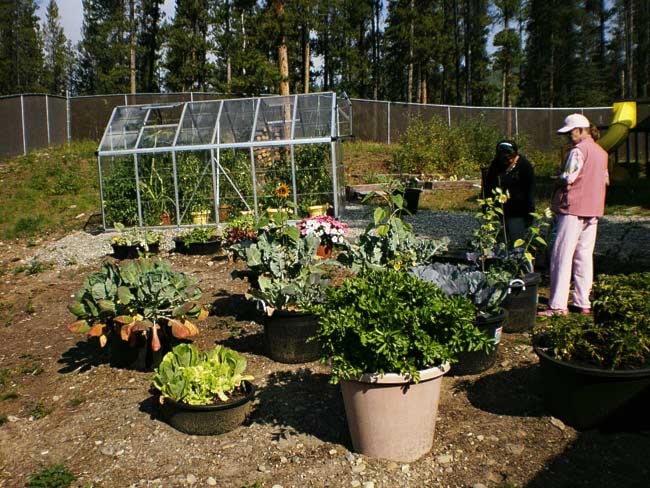It takes hope to plant a seed and help it grow.
Gardening imposes optimism on the gardener, and the faith they must have that those little seeds will turn into flowers can spread into other areas of their lives.
Monica Langmaid began researching the science behind this process after seeing it happen right in front of her.
The Help and Hope for Families Society in Watson Lake had been trying to make its yard look nicer, more welcoming and comforting.
One support worker at the shelter, Sharon Miller, a well-experienced green thumb, decided to start framing the front entrance with potted plants.
“The year I started this whole planting thing, my biggest helpers were two kids that were staying here,” said Miller. “A brother and sister, six and nine years old, and they were my right hand. They were just fascinated by everything that we did.
“I saw the two of them about three months ago in Whitehorse, and all they could talk about was how now, when they’re at home, they grow flowers.
“‘Just like how you showed us,’” she recounted them telling her.
This past winter, Miller brought up the idea of expanding the potted plants into the shelter’s backyard.
Langmaid, the shelter’s program co-ordinator, began building a compelling case so work on the huge yard could come together this summer.
“There have been a number of projects around the world using gardening,” she said. “One that really stood out for me was a group in Great Britain called Thrive. They’re doing therapeutic gardening with victims of torture who’ve fled their home country. What they have said is there’s a joy that comes from planting and cultivating new life.
“For someone who might feel like their life has been beaten down, sometimes literally or figuratively, to participate in something like this is very significant. Gardening is a holistic activity; it engages a person physically, mentally, emotionally and spiritually. Encouraging balance in all of those areas is very important for somebody who’s been abused.”
[image2]
Langmaid found study upon study that looked at gardening’s effects on mood, depression, concentration and stress.
With support from the community, like free bulldozer work and pro bono gravel and soil, the shelter’s large - and largely unused - backyard slowly took shape into a beautiful yard, garden and greenhouse this June.
The therapeutic effects of the garden were immediately obvious, said Miller.
Even during the winter, the women were invited to help plan the garden and pick what plants to grow. It brought enthusiasm back to some woman who came to the shelter “very traumatized and at their wits’ end as to what their life is going to be,” said Miller.
Miller remembers one woman in particular. “She came from one of the worst, abusive situations that I’ve seen.
“She’s been here before and just totally comes to this place with a heart that needs to heal.
“She looked around, saw that we needed to do a cleanup back there and she picked up a one-gallon bucket and she worked out there for hours.
“And the smile on her face! She came and thanked me for it afterwards. She loves to spend her time back there. She works her heart out. She was out there everyday that she was here. Just hanging out in different parts of the garden. She would just sit out there and you could just see the peace come over her.”
The Help and Hope Healing Garden is entirely container-based right now. The portability of the potted flowers and vegetables show the women they can do this on their own and carry it with them wherever they may need to go, said Miller and Langmaid. But the shelter is also hoping to build some flower beds in the future.
And there are plans to develop a space just for kids and to work with the Kaska First Nations to incorporate more medicinal and traditional plants.
The tomatoes that fill the small greenhouse and the pea patch that climbs up donated grocery carts in one corner of the yard have already helped supplement the shelter’s groceries.
“A big part of this program is to help promote better nutrition,” said Langmaid, adding that eventually they hope to donate to the food bank and maybe even set up a market stand.
There are also plans to keep the momentum in the winter months with seed, soil and garden-planning classes as well as indoor containers.
The learning piece to the program is huge, said Miller, remembering one woman that pointed to young, green tomatoes in the greenhouse and asked what was wrong with them.
“She didn’t know tomatoes started out green,” said Miller, who has been gardening for nearly 40 years. “It’s all stuff I know and it’s a real treat to be able to pass it on to these women that so appreciate it and love it.”
But even if the women come and go from the Help and Hope Healing Garden without learning or taking much, the garden’s effects are still apparent, said Miller.
“Something just washes over them,” she said. “They can escape into a world that is all about positivity and they feel so good.”
The Help and Hope for Families Society has 12 beds for women and children, who can stay for up to 30 days. There are also four second-stage housing apartments available for one-year leases, at situation-based rates.
Contact Roxanne Stasyszyn at
roxannes@yukon-news.com
